



To identify the food component characteristics of seven edible pufferfishes (five wild pufferfishes including striped puffer
난류성 어류인 복어(pufferfish)는 우리나라 및 일본 근해에 약 40여종이 서식하고 있으며, 이 가운데 식용 복어는 주로 복어목 복어과에 속하는 자주복을 비롯하여 황복, 까치복, 흑밀복, 은밀복, 검자주복, 검복, 매리복, 졸복 및 복섬 등 20여종이 있다(Kim et al, 2001; KORDI, 2004; NFFC, 2000). 년간 국내에서 생산된 자연산 복어의 양은 약 2,200-3,800톤, 양식산은 60-120톤으로 수요 또한 수입산(5,800-9,300톤)을 포함하여 10,000톤 이상 소비되는 국내 최고 인기어종 중의 하나이다. 복어는 맛이 시원 담백하며 영양학적으로도 우수하며, 그 열수추출물은 숙취 후 간 해독효과 등 기능특성을 지니고 있는 것으로 알려져 있다(Kim et al., 1994). 현재까지 복어와 관련된 연구는 tetrodotoxin 및 tetrodotoxin에 의한 식중독 발생 특성에 관한것이 대부분으로 국내외에서 여러 연구자에 의해 다수 보고되어 있다(Jeong et al., 1994; Jeon et al., 2000; Kim et al., 2003; Kim et al., 2007; Noguchi et al., 1991; et al., 2003; Tsubone et al., 1988). 식용 복어의 식품성분에 대한 연구로는 복어 지방질의 성분특성(Jeong et al., 1999), 복어 열수추출물의 정미성분 및 영양성분의 조성(Yang et al., 1990; Yun et al., 2009)에 관한연구, 음주 후 숙취해소기능 등 복어 추출물의 기능성에 관한 연구(Kim et al., 1994)가 수행되어 있다. 또한, 복어의 효율적 활용을 위한 가공에 관한 연구로 복어 내장지질의 활용 및 안전성 (Choi, 2003; Lee, 1997), 복어 통조림의 가공 및 열처리에 의한 감독(減毒) 효과(Kim et al., 2000), 무독성 황복을 이용한 건강보조식품의 제조방법(Un, 2005) 등 복어의 식품성분 조성과 가공에 관한 연구 및 특허출원이 부분적으로 진행된 바 있다. 그러나 현재까지 국내 연안에서 서식하고 있는 자연산 및 양식산 식용 복어류의 식품성분 특성을 종합적으로 분석 비교한 연구는 아직까지 보고된 바 없다. 따라서 본 연구는 국내 자연산 식용복어의 가치증진 및 향후 대량생산이 기대되는 양식 복어의 효율적인 활용을 위한 식품학적 자료를 얻기 위해 연안에서 어획되는 까치복, 검자주복, 검복, 은밀복 및 복섬 등 자연산 복어 5종과 황복 및 자주복 등 양식산 복어 2종의 영양성분 및 정미성분 특성을 분석 비교하였다.
실험에 사용한 식용 복어는 복어가 연중 가장 맛이 있는 시기인 2011년 1 월말에 국내 연안에서 어획한 자연산 까치복 (striped puffer,
[Table 1.] Length and weight of seven kinds of cultured and wild edible pufferfishes
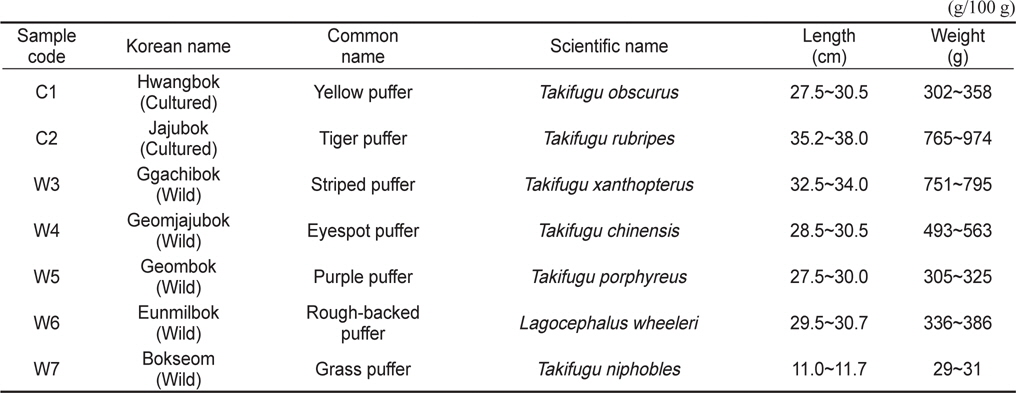
Length and weight of seven kinds of cultured and wild edible pufferfishes
일반성분의 조성은 상법(KSFSN, 2000a)에 따라 수분 함량은 상압가열건조법, 조단백질 함량은 semi-micro Kjeldahl 법,조지방 함량은 Soxhlet 법, 회분 함량은 건식회화법으로 측정하였다.
pH는 시료를 균질화한 다음 pH meter (Accumet Basic, Fisher Sci. Co., USA)로 측정하였고, 산도(acidity)는 pH와 염도를 측정한 시료 용액의 pH가 8.3이 될 때까지 적정하고, 이때 소모된 0.1 N NaOH 용액의 mL 수로 나타내었다(JSSRI, 1985). 휘 발성염기질소(volatile basic nitrogen, VBN)는 Conway unit를 사용하는 미량확산법(KSFSN, 2000b)으로, 아미노질소(NH2-N) 함량은 Formol 적정법(Ohara, 1982a)으로 측정하였다.
색조는 직시색차계(Color difference meter ZE-2000, Nippon Denshoku Ltd., Japan)를 사용하여 시료 육 표면의 색조에 대한 L 값(명도), a 값(적색도), b 값(황색도) 및 ΔE 값(색차)을 측정하였다. 이 때 표준백판(standard plate)의 L, a 및 b 값은 각각 99.98, 0.01 및 0.01이었다.
총아미노산 함량은 시료와 6.0 N HCl 용액을 혼합하여 heating block (HF 100, Yamato Co., Japan)으로 24시간 분해시킨후 감압건조하고, sodium citrate buffer (pH 2.20, 0.20 M)로 정용한 후 아미노산 자동분석기(Biochrom 30, Biochrom. LTD, England)로 측정하였다.
Bligh and Dyer (1959)의 방법에 준하여 시료의 총지질을 추출하고, AOCS Official Method (AOCS, 1990)에 따라 검화 및 methylester화시킨 다음, iso-octane을 가해 지방산을 분리 후 capillary column (Supelcowax-320, Supelco Japan Ltd., Japan)이 장착된 GC (GC-17A, Shimadzu Co., Japan)로 분석하였다. 이 때 GC의 분석조건은 Kim et al. (1994)의 분석방법과 같고, 각 구성 지방산의 동정은 표준품과의 머무름시간 비교 및 equivalent chain length법(Ackman, 1989)에 의해 동정하였다.
무기질은 시료에 진한 HNO3을 가해 습식분해(Ohara, 1982b) 시킨 후 ashless filter paper (Toyo 5B, Toyo Co., Japan)로 여과하여 일정량으로 정용한 다음, ICP (Inductively Coupled Plasma Atomic Emission Spectrometer, Atomscan 25, TJA Co., USA)로 Na, K, P, Ca, Mg, Fe, S, Zn, Cu 등의 무기이온과 Hg, Cd, Pb 등의 유해 중금속 함량을 분석하였다(Yoo et al., 1984).
시료에 3 배량의 70% ethanol 용액을 가하여 균질기(Ultra Turrax T25, IKA, Janke & Kunkel GmbH & Co., Germany)로 균질화한 후 17,000×g에서 15분간 원심분리하였다. 이 조작을 2회 더 반복하여 얻은 상층액을 모아 감압농축한 후 증류수로써 일정량으로 정용하였고, 여기에 5‘-sulfosalicylic acid를 10% 정도 첨가하여 하룻밤 방치 및 여과한 후 정미성분 분석용 엑스분으로 사용하였다. 유리아미노산 및 관련화합물은 시료 엑스분을 일정량 취해 감압건조한 다음 lithium citrate buffer (pH 2.20, 0.20 M)로 정용한 후 아미노산 자동분석기 (Biochrom 30, Biochrom. LTD, England)로 분석하였다. 그리고, 시료 복어 엑스분 맛의 강도에 미치는 각 유리아미노산의 영향은 각각의 유리아미노산 함량을 Kato et al.(1989)이 제시한 정미성 유리아미노산의 역치(threshold)로 나누어 얻어진 taste value로 나타내었다. 트리메틸아민옥사이드(TMAO) 및 트리메틸아민(TMA) 함량은 Hashimoto and Okaichi (1957)의 방법, 총 크레아티닌(total creatinine)은 Sato and Fukuyama (1958)의 방법에 따라 측정하였다.
국내 양식산 복어 2종 및 자연산 복어 5종 육의 일반성분 조성을 분석한 결과를 Table 2에 나타내었다. 양식 및 자연산 복어의 수분 함량은 78.4-80.4%, 조단백질 함량은 15.3-17.4%, 조지방은 0.7-1.6%, 그리고 회분 함량은 1.0-2.3%로서 복섬을 제외하고, 종류에 따른 일반성분 조성 차이는 거의 없었는데, 이러한 식용 복어의 일반성분 조성은 대체로 타 해산 백색육 어류와 비슷한 경향을 보였다(NFRDI, 2009). 한편, 소형 복어인 복섬은 다른 시료 복어에 비해 수분과 조지방 함량은 다소 낮은 반면, 조단백질과 회분 함량이 약간 많았다.
[Table 2.] Proximate composition in muscle of cultured and wild edible pufferfishes
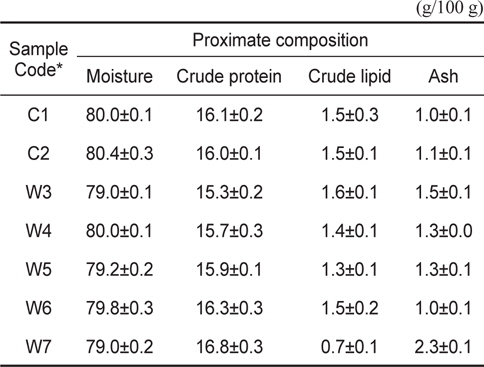
Proximate composition in muscle of cultured and wild edible pufferfishes
국내 양식산 및 자연산 복어 육의 pH, 산도, 아미노질소 및 휘발성염기질소 함량을 측정한 결과는 Table 3과 같다. 양식 및 자 연산 복어의 pH는 6.0-6.7로 까치복의 경우만 약간 낮았을 뿐 종류에 따른 차이는 거의 없었고, 사후 육의 산성화도 거의 인지되지 않았다. 육중의 유기산 함량을 간접적으로 알 수 있는 산도는 양식산인 황복과 자주복이 대체로 자연산 복어들에 비해 낮았으며, 복섬은 31.6 mL 로 타 시료 복어에 비해 월등히 높았다. 어패류의 맛에 관여하는 아미노질소 함량의 경우 자주복이 156.4 mg/100 g으로 가장 많았으며, 다음이 까치복, 은밀복 순이었고, 복섬이 84.5 mg/100 g으로 가장 적었다.
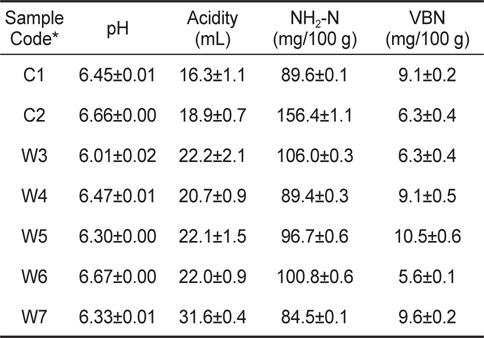
pH, acidity, amino-N (NH2-N) and volatile basic nitrogen (VBN) contents in muscle of cultured and wild edible pufferfishes
국내 양식산 및 자연산 복어의 보통육 표면 색조를 직시색차계로써 측정한 결과는 Table 4와 같다. 양식산 황복과 자주복, 그리고 자연산 까치복은 명도(L 값)가 높고 적색도 a값) 및 색차(ΔE 값)가 낮아 육색이 다른 시료 복어 육에 비해 희고 밝은 색조를 띠고 있으며, 이들 간에 색조의 차이가 거의 없음이 확인된 반면, 자연산 검복과 은밀복의 경우는 대체로 L 값이 낮고 a 값과 ΔE 값이 높아 육색이 약간 어둡고 적갈색을 띠는 것으로 나타났고, 이는 육안으로도 확인되었다. 따라서 국내산 식 용 복어의 경우 어종에 따라 육색이 약간씩 차이가 있음을 알수 있었다.
[Table 4.] Color values in ordinary muscle of cultured and wild edible pufferfishes
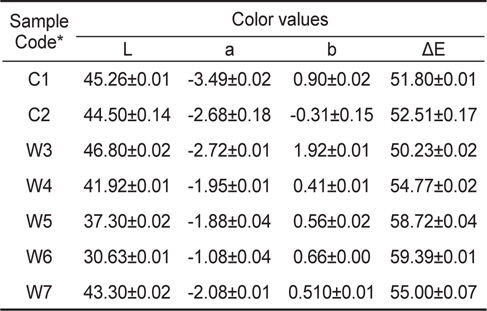
Color values in ordinary muscle of cultured and wild edible pufferfishes
총아미노산
국내 양식산 및 자연산 복어 육의 총아미노산 조성과 함량을 분석한 결과는 Table 5와 같다. 양식 및 자연산 복어 육의 아미노산 총함량은 14,941-16,427 mg/100 g으로 복섬의 총아미노산 함량이 가장 많았고, 까치복이 가장 적었으나, 종류에 따른 총함량 차이는 거의 없었다. 주요 아미노산으로는 양식 및 자연산 복어 모두 약간씩의 차이는 있으나 aspartic acid, glutamic acid, glycine, alanine, leucine, lysine 및 arginine의 함량이 많았고, 그 외 다른 아미노산들도 고루 함유되어 있었다. 어종에 따라 각 구성아미노산의 함량은 다소 차이를 보였지만 총함량에 대한 조성 비율은 대체로 비슷하였다.
[Table 5.] Total amino acid contents in muscle of cultured and wild edible pufferfishes
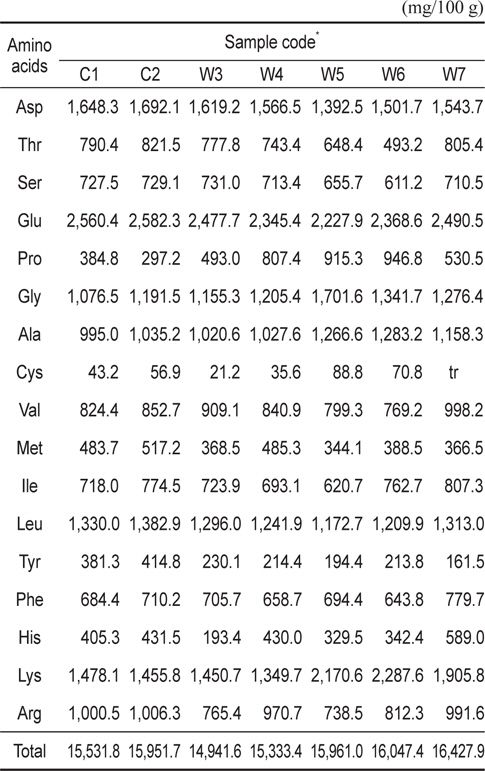
Total amino acid contents in muscle of cultured and wild edible pufferfishes
국내 양식산 및 자연산 복어 육에서 추출한 총지질의 구성 지방산 조성을 분석한 결과는 Table 6과 같다. 양식 및 자연산 복어의 주요 지방산은 16:0 (16.5-19.9%), 18:0 (6.6-8.4%), 18:1n-9 (9.0-16.8%), 20:4n-3 (4.0-7.8%), 20:5n-3 (7.1-8.6%), 22:5n-3 (3.5-8.7%) 및 22:6n-3 (18.9-29.5%) 등으로 복어 종류에 따라 약간의 조성 차이를 보였다. 특히, 복섬의 경우 다른 복어에 비해 20:5n-3 및 22:6n-3의 조성비가 낮은 반면에 16:1n-7 및 18:1n-9 등 모노엔산의 조성비가 높은 점이 특징적이었는데, 이는 복섬의 서식환경 및 식이의 차이에 기인한 것으로 생각된다. 한편, 기능성 지방산인 20:5n-3, 22:5n-3 및 22:6n-3 등 n-3계 고도불포화지방산(n-3 PUFA)의 조성비는 38.0-47.9%로 매우 높아 국내산 식용 복어의 근육 지질은 건강기능학적으로 매우 우수하다고 생각된다.
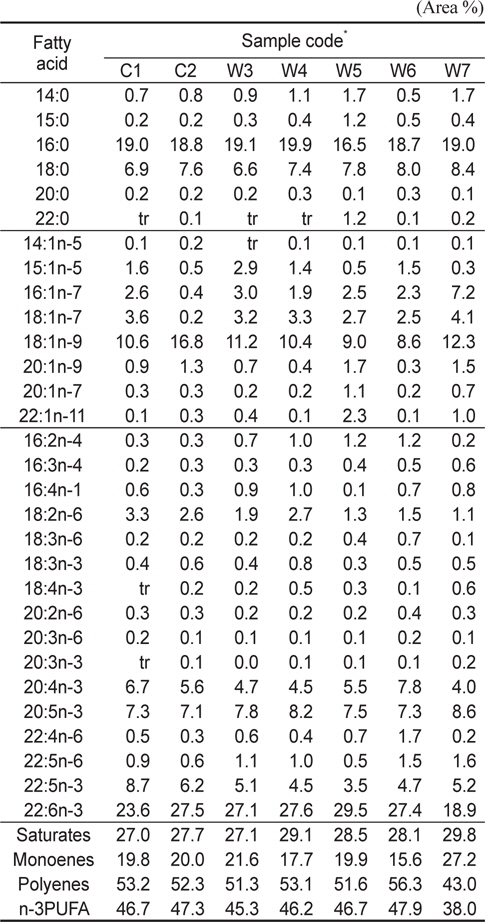
Fatty acid composition of total lipid separated from muscle of cultured and wild edible pufferfishes
국내 양식산 및 자연산 복어 육의 무기이온 및 유해 중금속 함량을 분석한 결과를 Table 7에 나타내었다. 양식 및 자연산 복어 육의 주요 무기이온은 K (125.2-188.0 mg/100 g), P (120.2- 140.6 mg/100 g), Na (79.7-112.1 mg/100 g), S (55.8-113.2 mg/100 g) 및 Ca (23.0-34.4 mg/100 g) 등으로 복어 종류별 및 각 구성 원소에 따라 다소의 차이를 보였으나, 총함량에 대한 조성비는 대체로 비슷하였다. 이중 S의 경우 함황화합물의 역치가 0.02-0.33 ppb로 매우 낮기 때문에 조리시 유리되어 복어의 구수한 향미 생성에 영향을 미치며(Oda, 1981; Park et al., 1994a), Na+, K+, Cl- 및 PO4 3- 등 무기이온이 자숙 게 육의 주된 정미발현성분(Hayashi et al., 1981)이라는 점을 고려할 때 이들 성분들은 복어의 맛에 크게 기여할 것으로 보인다. 한편, Hg, Cd와 같은 유해성 중금속은 검출되지 않았으며, Pb의 경우 일부 시료 복어 육에서 검출되었으나 기준치 이하로 위생상의 문제점은 없었다.
[Table 7.] Mineral and heavy metal contents in muscle of cultured and wild edible pufferfishes
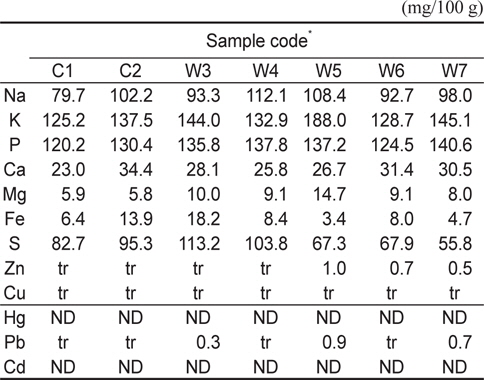
Mineral and heavy metal contents in muscle of cultured and wild edible pufferfishes
국내 양식산 및 자연산 복어 육에서 추출한 엑스분의 tasteactive compounds 인 유리아미노산 조성과 함량을 분석한 결과는 Table 8과 같다. 양식 및 자연산 복어 엑스분의 유리아미노산 총함량은 236.4-428.1 mg/100 g으로, 다른 해산어류와 비교해 볼 때 일반 백색육 어류와는 유리아미노산 총함량이 거의 비슷한 반면, 비교적 맛이 농후한 적색육 어류에 비하면 함량이 적은 것으로 나타났다(Park et al., 1994b). 까치복의 유리아미노산 총함량이 가장 적은 반면, 검복의 유리아미노산 함량이 가장 많았다. 주요 유리아미노산으로는 taurine이 69.5-131.0 mg/100 g으로 가장 많았고, 검복과 복섬에 많이 함유되어 있었다. Taurine (Park et al., 2000a)은 삼투압조절 등 물질대사에 관여하는 기능성 함황아미노산의 일종으로 복어 조리시 생기는 냄새의 형성에 일부 기여할 것으로 생각된다. 다음으로 lysine의 함량이 많았으며(34.9-77.4 mg/100 g), 정미성 아미노산인 proline, glycine, alanine 및 arginine (Kim, 1985)도 비교적 많이 함유되어 있는 반면, 감칠맛의 주성분으로 수산물 엑스분의 맛에 크게 관여하는 glutamic acid의 함량이 적은 점이 특이하였다. Arginine은 쓴맛을 지니나 적당량 함유되면 진한 맛을 내게 하여 전체적으로 맛을 강화시킨다는 것이 밝혀져 있다(Park et al., 2000a). 복어 종류에 따라 이들 유리아미노산 개별 함량은 다소의 차이를 보였으나, 조성비는 대체로 비슷하였다. 아미노산 중 glutamic acid, proline, glycine 및 alanine은 대표적 정미성 아미노산(Kim, 1985)으로 알려져 있고, 유리아미노산이 수산물의 가장 중요한 맛성분(Park et al., 2000b)이란 점을 고려할 때 이러한 유리아미노산의 함량 차이는 식용 복어의 맛 특성에 상당한 영향을 미칠 것으로 생각되었다.
[Table 8.] Free amino acid contents in muscle extract of cultured and wild edible pufferfishes
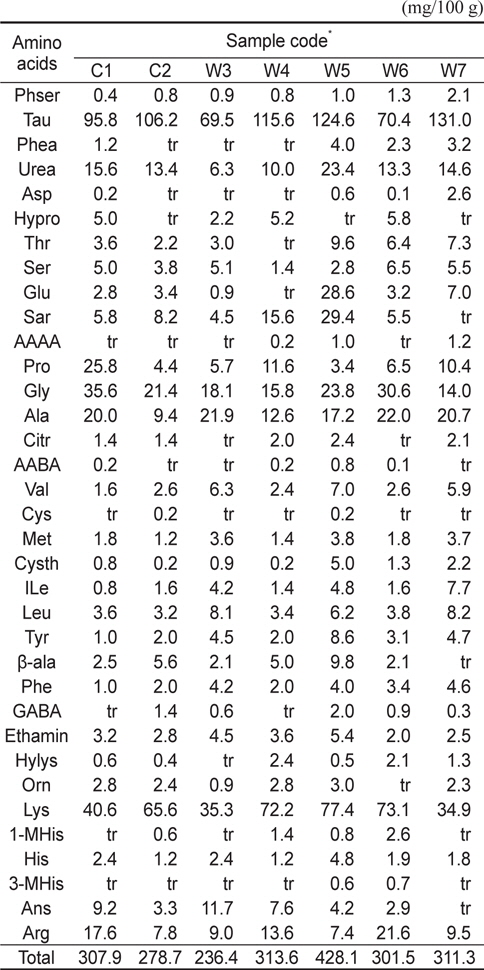
Free amino acid contents in muscle extract of cultured and wild edible pufferfishes
양식 및 자연산 복어의 유리아미노산 분석 결과값(Table 8)을 Kato et al. (1989)이 제시한 맛의 역치로 나누어 나타낸 taste value는 Table 9와 같다. 정미성 아미노산 맛의 강도를 나타내는 total taste value는 검복이 9.31로 가장 높았고, 다음이 복섬, 은밀복, 황복, 까치복, 검자주복 및 자주복 순으로 엑스분의 강도가 강함을 알 수 있었다. 한편, 본 taste value 및 정미특성으로 보아 복어 엑스분의 맛에 크게 영향을 미치는 아미노산으로는 복어 종류에 관계없이 대부분 glutamic acid, alanine, glycine, aspartic acid 및 arginine 등일 것으로 생각되었다.
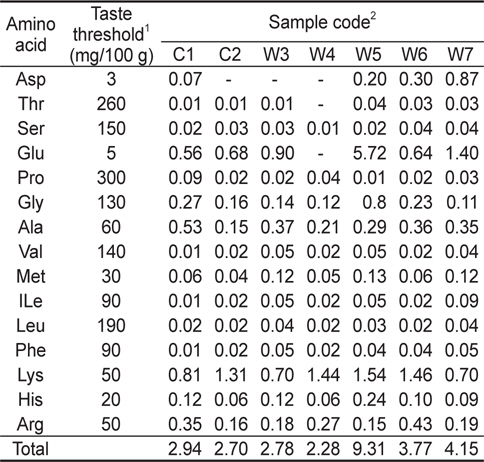
Taste values of free amino acids in muscle extract of cultured and wild edible pufferfishes
양식 및 자연산 복어 엑스분의 트리메틸아민옥사이드(TMAO)와 트리메틸아민(TMA), 그리고 총 크레아티닌 등 기타 염기성분의 함량을 분석한 결과는 Table 10과 같다. 양식 및 자연산 복어 엑스분의 TMAO와 TMA의 함량은 각각 22.2-38.9 mg/100 g과 1.3-3.3 mg/100 g으로 복어의 종류에 따른 차이는 거의 없었고, 일반 해산어류에 비해 그 함량이 비교적 소량이었다. 시료 복어 중 검복이나 은밀복의 경우 다른 복어에 비해 TMAO 함량이 적고, TMA 함량은 다소 많았는데, 이는 선상동결 저장중 TMAO의 일부가 TMA로 환원되었기 때문으로 생각된다. TMA는 미량이지만 역치가 대단히 낮기 때문에 이들이 복어의 조리 및 가공시 냄새 생성에 어느 정도 기여할 것으로 보인다(Oda et al., 1981). 한편, 수산물의 떫은맛에 관여하는 성분인 total creatinine (Russel and Baldwin, 1975) 함량은 255.0- 385.5 mg/100 g으로 복어의 종류에 따라 다소의 차이를 보였는데, 복섬이 가장 적은 반면, 자주복과 검자주복의 함량이 가장 많았다.
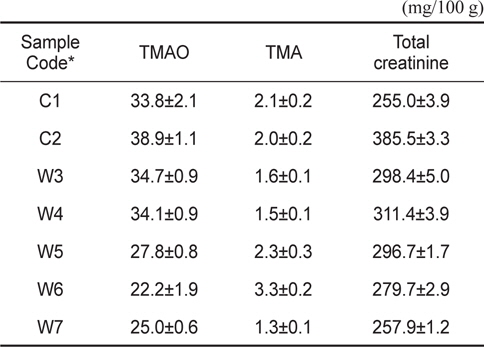
Trimethylaminoxide (TMAO), trimethylamine (TMA) and total creatinine contents in muscle extract of edible pufferfishes









